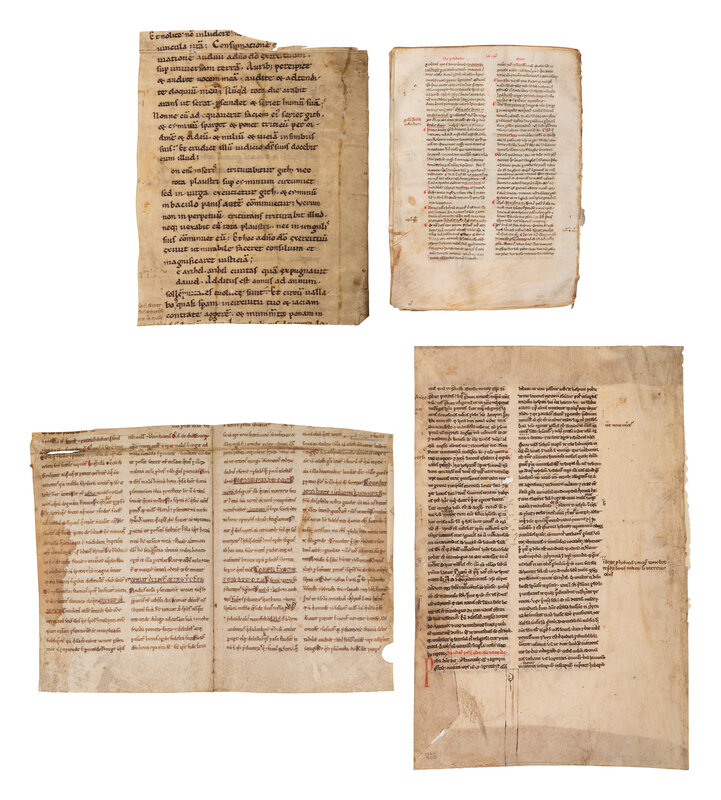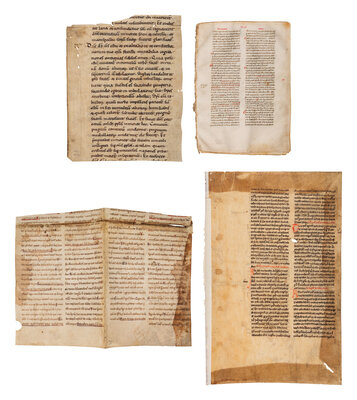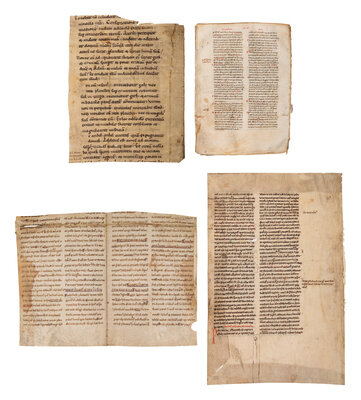Lot 31
Collection of leaves, bifolia, and quires from English, German, and Italian manuscripts of the 12th to 14th centuries (4 items)
Sale 2033 - Western Manuscripts and Miniatures
Jun 27, 2024
10:00AM CT
Live / Chicago
Own a similar item?
Estimate
$800 -
1,000
Price Realized
$3,493
Sold prices are inclusive of Buyer’s Premium
Lot Description
Collection of leaves, bifolia, and quires from English, German, and Italian manuscripts of the 12th to 14th centuries (4 items)
Study group of considerable interest including biblical, theological, and devotional texts dating over three centuries.
(i) A partial leaf from a Bible, in Latin, manuscript on parchment [Germany, c. 1140-1160]
208 x 162 mm. Partial leaf, blind-ruled for one main column of at least 27 lines (written space at least 208 x 115 mm), written in dark brown ink in a distinctive protogothic script, glosses in a smaller script in the inner margin (some wormholes, slight stains, some browning on the edges, tape stain on the upper right corner of the verso, else in good condition).
This partial leaf comes from a portable Bible and contains the text from the Book of Isaiah, Old Testament, reading on the recto 24:22 to 25:8, and on the verso 28:22 to 29:3. The unusual script, with some fork ascenders and very pronounced ticks on minims, suggests that it was written in Germany in the years 1140 to 1160. Both the ruling and notes added in the inner margin indicates that the manuscript had been glossed.
Provenance
(1) Otto F. Ege (Gwara 2016, as HL 156).
(2) Sold by his heirs at Sotheby’s, London, 26 November 1985, item 2 of lot 39.
(3) Acquired by Maggs Bros.
(4) Marvin L. Colcker, Emeritus Professor of Classics at the University of Virginia, acquired from Maggs in 1985, his MS 374, as indicated by the shelfmark added in pencil in the lower outer corner of the verso.
LITERATURE
Published: Scott Gwara, Otto Ege’s Manuscripts, A Study of Ege’s Manuscript Collections, Portfolios and Retail Trade, 2013, p. 169, referred to as “HL 156.”
(ii) A partial bifolium from Haimo of Auxerre, Commentarium in Canticum Canticorum (Commentary on the Song of Songs), in Latin, illuminated manuscript on parchment [Germany, c. 1180-1200]
189 x 127 mm. Partial bifolium, ruled in brown ink in two columns of at least 24 lines (written space: 156 x 116 mm at least), written in dark brown ink in formal early gothic bookhand, capitals touched with red or silver, rubrics in capitals underlined in red or silver (signs of use as pastedown, dampstains partially affecting the legibility of text, parchment repair, else in good condition).
This leaf comes from a refined copy of the Commentarium in Canticum Cantirorum, erroneously attributed to Haymo, Bishop of Halberstadt (d. 853) in the Patrologia Latina. Athough recent scholars attribute this commentary to Haimo of Auxerre, it has circulated under the names of numerous authors. This refined copy included touches of red and silver on capitals and rubrics; it should be noted that the liquid silver has not oxidized, presumably because the bifolium was reused as a pastedown for a manuscript at an early stage. Only two lines must have been trimmed at top. The text thus reads almost continuously from “cortice purpureo…” (Migne, t. 117, col. 323 C) on the first column of the first recto, to “Lavi pedes meos, quomodo” (col. 328 A) on the second column of the second verso.
Of the many medieval commentaries on the Song of Songs, the ninth-century Commentary by Haimo of Auxerre was the most popular and widely disseminated. Haimo of Auxerre (fl. ca. 840-860) was a Benedictine monk from the Abbey of St.-Germain at Auxerre, an important center of learning, and especially of biblical exegesis. In addition to this commentary on the Song of Songs, Haimo was the author of commentaries on the Apocalypse, the Minor Prophets, and possibly the Pauline Epistles, and many sermons.
Haimo’s commentary was ideally suited to the classroom, and its popularity can be explained by its straightforward and didactic approach, which focuses on the Song of Songs as an allegory of Christ and the Church. His commentary was simple enough to appeal to the monastic world of the ninth century, and to both monastic and secular audiences later in the Middle Ages. His skillful use of many earlier authors doubtless added to its appeal. Later in the Middle Ages, commentaries on the Song of Songs stressed a more complex, spiritual interpretation of the biblical text, focusing on the love of Christ and the human soul.
Provenance
Marvin L. Colker, Emeritus Professor of Classics at the University of Virginia, his MS 67, as indicated by the shelfmark added in the lower left corner of the recto.
LITERATURE
Text edited in J. P. Migne, Patrologia latina, Paris, 1841-61, 117:295-358 from the Cologne, 1529 edition, where it is attributed to Haimo of Halberstadt. On the text, see also E. Ann. Matter, The Voice of My Beloved. The Song of Songs in Western Medieval Christianity, Philadelphia, 1990.
(iii) A leaf from Peter of Poitiers, Historia Actuum Apostolorum, in Latin, manuscript on parchment [England, c. 1200-1250]
300 x 192 mm. Single leaf, ruled in plummet for two columns of 40 lines, including one on top of upper line (written space: 204 x 120 mm), written in brown ink in a gothic book hand, additions by the same hand in the outer margin, rubrics in red, four two-line initials in red, extending into the margins (remains of adhesive on the outer margin of the recto, three-sided browning on the verso typical of use as pastedown, marks of five raised bands on the verso, two small parchment holes, else in good condition).
This leaf comes from a copy of Peter of Poitiers (c. 1130-1215), Historia actuum apostolorum, written as a continuation to Petrus Comestor’s Historia scholastica. The text aimed to summarize the content of the Acts of the Apostles. This leaf recounts the famous episode of the baptism of Roman centurion Cornelius by St. Peter (Apostles 10). The text reads from “[pie]tatis, quia in graduli ascensu” to “Tunc rogaverunt eum. Et mansit rogatus cum,” (Patrologia Latina, 198, 1645-1722) and includes the sections devoted to the conversion of Cornelius (beginning imperfectly), the vision of St. Peter, the arrival of St. Peter and the calling of Cornelius, and the baptism of Cornelius (ending imperfectly).
After studying at the University of Paris, Peter of Poitiers (c. 1130-1215) succeeded Peter Comestor in the Chair of scholastic theology in 1169. His lectures were considered brilliant, and he wrote commentaries on the Bible, many of them still unedited (on Exodux, Leviticus, Numbers). He wrote the Historia actuum apostolorum as a continuation of Petrus Comestor’s Historia scholastica, summarizing the Acts of the Apostles. Both texts were often transmitted together.
Provenance
Marvin L. Colker, Emeritus Professor of Classics at the University of Virginia, his MS 402, as indicated by the shelfmark added in the lower left corner of the recto.
(iv) A quire of twelve leaves from Ricardus de Sancto Laurentio, De laudibus beatae Mariae Virginis, in Latin, manuscript on parchment [Italy, c. 1300]
185 x 135 mm. A quire of 12 leaves, including string, ruled in plummet for two columns of 40 lines (written space: 135 x 90 mm), with running titles on top, written in brown ink in a small gothic book hand, capitals touched with red, rubrics in red, quotes underlined in red, running titles in red, marginal annotations often framed with red, two- to four-lines initials alternately in red and blue (parchment cockled, slight browning, else in good condition).
This quire in good condition comes from an as-yet unidentified copy of Richard of Saint-Laurent’s De laudibus beatae Mariae Virginis. This long Mariale, praising the Virgin Mary, was written by Richard de Saint-Laurent, dean of the chapter of Rouen, who died around 1250. Originally attributed to Albert the Great, the text consists of twelve chapters that provide an encyclopedic view of theological reflection on the Virgin Mary. The quire was part of the fourth and fifth chapters: its texts comments on the largesse, the piety, the softness, the sanctity, the obedience, the wisdom, the verb, the taciturnity, and the beauty of the Virgin Mary.
Provenance
Marvin L. Colker, Emeritus Professor of Classics at the University of Virginia, his MS 523, as indicated by the shelfmark added in the lower left corner of the first recto.
Freeman’s | Hindman thank Senior Consultant Sandra Hindman and Elliott Adam for their assistance in preparing this sale.
Condition Report
Contact Information



